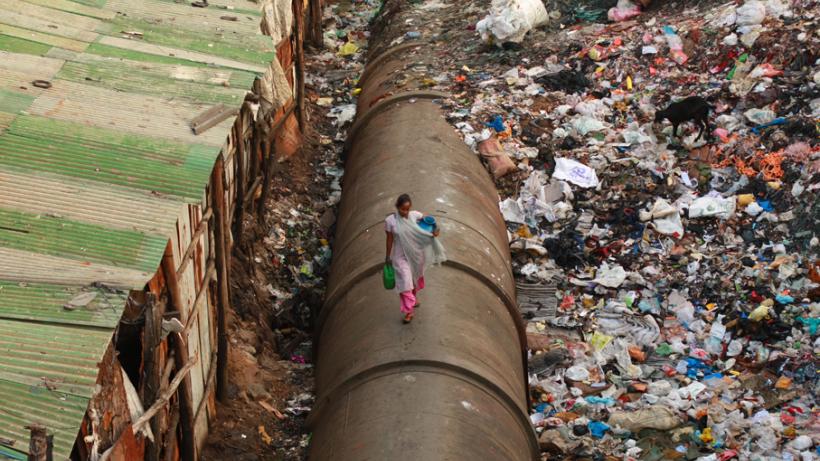
Slums can transform peoples’ lives for the better
Some rural dwellers in the Global South are increasingly viewing slums as a way to improve their lives, says Ralf Bodelier.
Many may think life in a slum is miserable. And they are right. Slums are pathetic. They are dirty, overcrowded and dangerous. Even slum residents themselves also think there is an awful lot to improve.
Nonetheless, each year 60 million people in Africa, Asia and Latin America exchange their lives in a rural area for a life in the slums. And they do so for good reasons. Those who leave their village hope to leave behind extreme poverty; high infant mortality rates and complete darkness from six in the evening to six in the morning. For millions of people in the countryside of the Global South, slums hold a promise.
In Ndirande, an immense slum in Malawi, lives the cook and entrepreneur Filesi Panja (28). Life in the village, says Filesi, was beautiful, safe and quiet. But it was also poor, boring and, above all, hopeless. As a youngster Filesi heard about the fast life in Blantyre, the big Malawian city that encompasses Ndirande slum. She picked up stories about street lights, the opportunities to make money and the chance to send children to school. At that time it was hard for her to imagine how life would be outside her village.
‘People in Ndirande are not poor because the slum makes them poor’, tour guide Saulos Jali explains to his visitors. ‘People want to live in Ndirande because they are poor.
Now she has a restaurant at Ndirande market. That is to say: Filesi dug a few holes near a wall, suitable for some log fires and pots of water. Every morning just after six o’clock she enters the market. Filesi ignites the fires and buys some chicken, vegetables and peanut powder. At about eight o’clock she starts to prepare forty meals. At exactly twelve o’ clock she serves them out to market vendors. By doing so, she makes about US$700 per month. The average Malawian earns about US$250 monthly.
By Western standards, Felisi’s kitchen is staggeringly basic and shabby, but she views it differently. Thanks to her restaurant, Filesi can take care of herself and her children, whom she can send to school. Besides that, she supports her mother in the village and her sister at university. Filesi is full of pride when she reveals how she escaped from the extreme poverty in her village. ‘My life is light now,’ she says.
Filesi Panja is one of the thirteen residents of Ndirande slum that we filmed last summer for our web documentary ‘Slums: Engines behind the development goals’. It is a documentary about the opportunities that slums like Ndirande offer to their residents.
Compared with life in African villages, life in most African slums is less bad. According to UN HABITAT, 49 per cent of the children in the rural areas of Malawi are malnourished. In a Malawian slum like Ndirande that percentage is about 41. In Malawian villages, 80 percent of the children enrol in primary school. In Ndirande that percentage is more than 90. In Malawian rural areas, seven per cent of the young women are able to find a paid job, in Ndirande about 20 per cent are. In rural areas of Malawi, virtually no one has access to electricity, compared to more than 30 per cent of the residents in Ndirande. And these are only the measurable, tangible benefits. Equally important is the desire of young people in villages to join modern life and break free from boredom, patriarchal relations and old traditions.
Today, Africa is the least urbanised continent. Sixty percent of all Africans live in the countryside compared with, for example, 17 per cent in the United States. But nowhere in the world is urbanisation occurring as fast than in Africa. Within fifteen years, the majority of Africans may live in cities. By then, these cities will mainly consist of slums. Out of the ten billion people who will inhabit the world in 2050, about three billion will be slum dwellers. Today that number is still one billion.
More than twenty years ago I visited Ndirande for the first time. That time, I mainly saw the misery of the masses who lived there. I gazed at the funeral processions, the weak and the sick, sometimes emaciated sitting on a mat in front of their house. I was shocked by the children in rags, the bars that protected the shops, the lame that scurried in the dust.
Over the years I started to understand why so many villagers were heading for places like Ndirande. Residents like Filesi Panja made me think. So did G’bray Sangala, a medical doctor from Ndirande who runs a school for the deaf in his free time. And so did Morris and Ng’oma, two beggars, one of them in a wheelchair, who are able to make a living on an exit road near Ndirande. The prostitute Thokozoni made me think, just as the blacksmith Madalitso Yohane and Saulos Jali, the only tourist guide in Ndirande. All of them know how nasty a slum can be. Yet they deliberately chose to live right here.
‘People in Ndirande are not poor because the slum makes them poor’, tour guide Saulos Jali explains to his visitors. ‘People want to live in Ndirande because they are poor. They expect to find a better life here than in the villages where they come from.’ That is why the slums of Blantyre are expanding and becoming increasingly congested. According to Jali, we should consider ‘slummification’ a compliment. Apparently there is something about the slum that ordinary Malawians want to be part of. It is an interesting notion, which, when it is right, could completely change our perception of the Southern slums.
Stay tuned for the photo essay tomorrow.
This blog was originally published on Africa@LSE, read the original.

